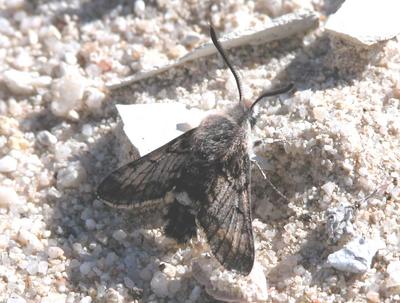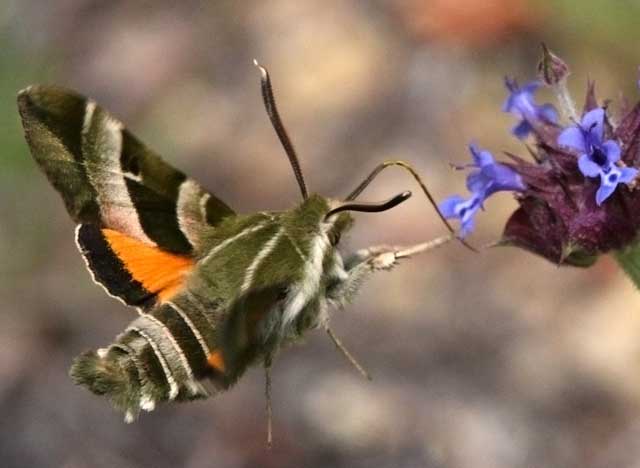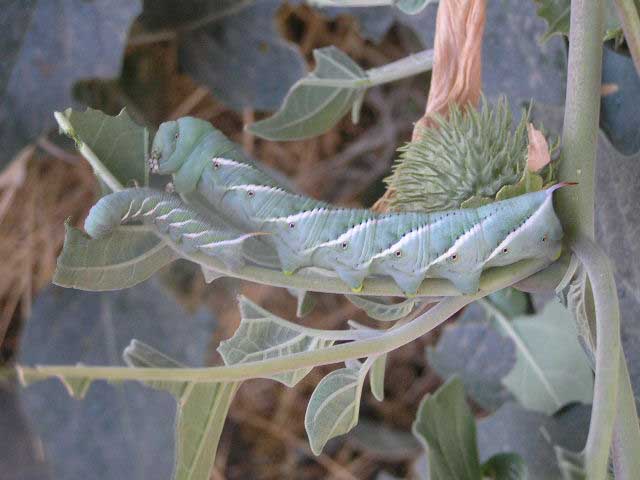San Benito County, California
Sphingidae

|
|
Created/dedicated as per personal communication with Paul Johnson Updated as per James P. Tuttle's The Hawk Moths of North America, September 3, 2008 Updated as per personal communication with Dave Gaban, April 14, 2013 Updated as per personal communication with Paul Johnson (Eumorpha achemon, Sphinx chersis); April 21, 2010 |


Proserpinus clarkiae, Pinnacles National Monument, San Benito County, California,
nectaring at chia (Salvia columbariae), courtesy of Paul Johnson.
It is hoped that this checklist, with the thumbnails and notes, will help you quickly identify the moths you have encountered.
A WO" after the species name indicates that I have no confirmed reports of this species in San Benito County, but I (William Oehlke) expect that this moth is present.
A USGS indicates the moth is reported on the USGS website and/or in Moths of Western North America, #2. Distribution of Sphingidae of Western North America, revised, an excellent little booklet available through Paul Opler.
Please help me develop this list with improved, documented accuracy by sending sightings (species, date, location), preferably with an image, via email to Bill Oehlke.
Sphinginae subfamily
courtesy of Eric Brunnemann, via Paul Johnson
Smerinthini Tribe:
September 2, 2008, courtesy of Candace Brewen, via Paul Johnson.
Smerinthus cerisyi: 20:30; Dave Gabon, Hollister, April 13, 2013
Macroglossinae subfamilyDilophonotini Tribe:
Philampelini Tribe:
Macroglossini Tribe:
courtesy of Paul Johnson.
courtesy of Paul Johnson
courtesy of Paul Johnson
|
"Here are the species I've found at Pinnacles, from San Benito County:
Arctonotus lucidus
Hemaris diffinis
Hyles lineata
Proserpinus clarkiae
Smerinthus cerisyi
Sphinx perelegans
"There is a specimen of Pachysphinx occidentalis from Pinnacles in the 1950's or 1960's in our museum.
"Finally, the Euproserpinus here appears to have characters of both phaeton and euterpe, and thus I'm leaning toward calling it a new species. It appears to also be found in San Luis Obispo County. Not sure what you want to do with that."
Paul also indicates that there is at least one tomato feeder in the county. I suspect both Manduca quinquemaculata and Manduca sexta are present.
March 17, 2007, Paul writes, "Today I spent the better
part of the day studying a population of Euproserpinus
sphinx moths at Pinnacles
National Monument in San Benito County, CA. Because
of the low rainfall, I thought this would be a poor
year for them. I was wrong. For 10 days now I've
been marking individuals and keeping track of where
they spend the night. Before today, I had seen only
males (14 different individuals). Today I saw about 9
individuals, including several females ovipositing.
I'm very interested to hear of other sightings of this
genus.
I also saw two Proserpinus clarkiae, just a few feet
from where a Euproserpinus had flown past me minutes
earlier. And a few Hyles lineata, including one that
hovered so close to my head that I felt the wind from
its wings. There's one outside on the window beside
me as I type."
"For years I've been asking locals to bring me hornworms from their gardens, with no success. Last year that all changed. I got them on my tomatoes, and two other
folks brought me some from their tomatoes and peppers. And ironically, just after that I found a large 5th instar larva walking across a road mid-day.
This was nowhere near human habitation, and the only solanaceous plant I could find in the area was Datura wrightii.
"I just recieved the attached photo from Eric Brunnemann. In his yard in San Benito Co. he has Manduca sexta larvae feeding on Datura wrightii.
"Here is the list of plants for which I have records of this species feeding in this county:
Datura wrightii, tomato, jalapeno pepper and serrano pepper."

Manduca sexta on Datura wrightii, San Benito County, California,
September 2, 2008, courtesy of Eric Brunnemann, via Paul G. Johnson.
Enjoy some of nature's wonderments, giant silk moth cocoons. These cocoons are for sale winter and fall. Beautiful Saturniidae moths will emerge the following spring and summer. Read Actias luna rearing article. Additional online help available.
Use your browser "Back" button to return to the previous page.
This page is brought to you by Bill Oehlke and the WLSS. Pages are on space rented from Bizland. If you would like to become a "Patron of the Sphingidae/Catocala Sites", contact Bill.
Please send sightings/images to Bill. I will do my best to respond to requests for identification help.
 Show appreciation for this site by clicking on flashing butterfly to the left. The link will take you to a page with links to many insect sites. |